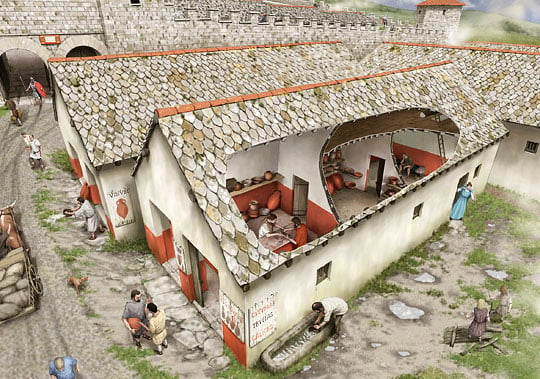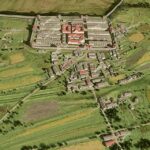In today’s blog we’re investigating the bustling life of the vicus, the civilian settlements that thrived outside the Roman forts across the Empire. Housesteads Roman Fort on Hadrian’s Wall was no different, enjoying a vibrant community fuelled by the economic activities of Roman soldiers.

Soldiers and civilians
The Roman army paid its soldiers in such a way that they had excess money left over when they received their wages. They were supplied with food, wine and uniforms and so had money left over to spend as they saw fit. This excess money led to the development of vici outside most Roman forts. Soldiers, equipped with the essentials by the army, spent their surplus on other goods, attracting tradespeople and workshops eager to sell to these soldiers
Life on the frontier
The harsh frontiers of Northern Britain didn’t deter the soldiers from enjoying luxuries like olive oil, spices, and wine, which were available at local shops along the vicus roads.
Life was quite tough on the frontiers so they sought to improve their daily lives with personal purchases. Their demand for luxury goods like wine, beer, spices and precious metal to embellish their uniforms to look more impressive. These purchases led to the growth of local businesses supplying these good, which in turn led to economic growth around the forts.

Family life in the vicus
While early regulations prohibited official marriages (because the army didn’t want to be responsible for children and wives) soldiers formed unions and families nonetheless. This caused trouble for the army in the event of a soldier’s death because they would want to leave their personal goods and money to their families. However, because these families were not officially joined by marriage, heirs often missed out on inheritance. Emperor Septimus Severus eventually agreed that soldiers were legally allowed to marry and their children would be recognised. This was a huge step forward for many soldiers and led to a rich family life just beyond the fort’s walls.

Civil unrest and growth
Despite civil wars and Britain’s temporary break from the Roman Empire in the 3rd century, the vici flourished, with population estimates soaring. This could have been because of funding from the central government, or it could be due to peace with tribes north of the wall, leading to the growth of trade, and creating a vibrant and safe place for people to live. Alternatively, it could have been that military spending was increased so that there were extra soldiers recruited to bolster the defence of England. In the 4th century though, these settlements seem to contract and disappear, possibly due to the conflicts that the wall experienced during that period.
Mystery and murder
Amidst the community’s growth, mysteries like the ‘Murder House’ in the vicus of Housesteads emerged. Two bodies were found under the ground, one of which had a knife in its back and had obviously been rapidly buried to conceal them. Had this been a drunken brawl? A planned attack? A raid by native Britons? What has happened to result in two dead bodies? This indicates such an interesting history of the vicus.
Even now, the ruins speak of a once-thriving hub of social and economic activity. If you’d like to immerse yourself in the history of the Roman Empire’s northern frontier, a tour of the vicus and its fort is highly recommended.


